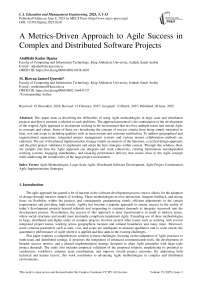A Metrics-Driven Approach to Agile Success in Complex and Distributed Software Projects
Автор: Abdillahi Kadar Djama, M. Rizwan Jameel Qureshi
Журнал: International Journal of Education and Management Engineering @ijeme
Статья в выпуске: 3 vol.15, 2025 года.
Бесплатный доступ
This paper aims at describing the difficulties of using Agile methodologies in large scale and distributed projects and then it presents a solution to such problems. The approach presented is the continuation of the development of the original Agile approach to incorporate working in the environment that involves multiple teams and remain Agile in concepts and values. Some of these are: broadening the concept of success criteria from being simply measured in time, cost and scope to including qualities such as team morale and customer satisfaction. To address geographical and organizational separations, integrated project management systems and various instant collaboration methods are endorsed. The use of the phased implementation strategy entails an analysis of the literature, a cyclical design approach, and the pilot project validation to implement and adopt the best strategies within context. Through this solution, there are insights into how the Agile approach can integrate and work cohesively, creating harmonious interdependent working systems, engaging stakeholders, and ensuring performance delivery that comes close to the Agile concept while addressing the complexities of the large project environment.
Agile Methodologies, Large-Scale Agile, Distributed Software Development, Agile Project Coordination, Agile Implementation Strategies
Короткий адрес: https://sciup.org/15019859
IDR: 15019859 | DOI: 10.5815/ijeme.2025.03.01
Текст научной статьи A Metrics-Driven Approach to Agile Success in Complex and Distributed Software Projects
The agile approach has gained a lot of traction in the software development process since it allows for the adoption of change through iterative models of working. These methodologies involve interaction, frequent feedback, and strong focus on flexibility within the projects and consequently guaranteeing timely efficient adjustments to the certain requirements and providing high results. Agility has become a popular approach to ensure success in the reality of today’s development projects beyond referrals and responding to customer demands to integrate teamwork into the development process. Nevertheless, the success of this approach is most transformative in small to midsize teams, where social structures and model must minimally complicate implement Agile. Extending use of these methodologies to large, distributed and higher order of complex projects involves several other issues such as working with several integrated project teams, working across geographical location and cultural boundaries and many more. Moreover, some common parameters such as time, cost, and scope are inadequate to measure qualitative and to some extent, the quantitative performance of Agile where it is applied and thus adds to the existing challenges.
This paper explores a comprehensive solution to these challenges, focusing on the adaptation of Agile practices to multi-team and distributed settings. It proposes the integration of enhanced communication tools, the development of broader success metrics, and a phased implementation strategy designed to align Agile principles with large-scale project demands. The study also includes empirical validation of the proposed solution, emphasizing its potential to synchronize workflows, enhance team coordination, and improve overall project outcomes. By addressing both technical and human factors, this work contributes to advancing Agile methodologies in complex and distributed environments.
2. Related Works
Analyzing the Agile practices described in the studies, it can be concluded that all practices have certain positive impacts, however, the sprints and retrospectives are more effective under different circumstances. There are some practices which need further investigation, for instance the self-organized teams. However, much focus was paid to the facilitation of a better understanding of the dynamics of Agile and that anyone implementing agile needs to understand the practices in question need to be adapted for the specific organizational setting, interactions between the teams, and the context to ensure that projects would be successful. All these findings pointed out means that Agile practices can have an influence on the outcome of the project depending on several factors including team size, culture and the type of project therefore every care should be taken to consider the circumstances of the project before the implementation of these practices. This requires uniformity of technical terms and an increased number of studies on the less popular Agile practices and to avoid hasty categorizing of the different practices.[1]
Choraś et al. [2] present a two-phase metric-based system designed for small software enterprises with specific recommendations on Agile application in SMEs. In regard to management objectives, their system combines quantitative measures related to the completion of tasks, with quantifiable measures of the processes undertaken in the course of the sprint. This framework was built by the authors from action research and includes feedback cycles which make it possible to evaluate efficiency at different stages. Through examples of values used in their products such as Jira and SonarQube, they illustrate how these metrics enhance a constant rise in product quality and cohesion in the team. The study addresses a large gap in Agile literature by providing specific and quantitative strategies that can help SMEs achieve Agile success.
Kandengwa and Khoza [3] propose non-traditional success measurement framework for estimating success in agile software projects with the perspective analyzing success as cost, scope, time and customer satisfaction, team satisfaction, and business value. Using the concept of Agile generally, they explain how other metrics, including burnup and burn-down charts, kanban flow efficiency, and Net Promoter Scores (NPS), are more accurate in measuring this iterative and adaptive nature of Agile. In their survey-based research, employing quantitative analysis methods such as IBM SPSS, the authors show how prioritizing such metrics facilitates better project performance and organizational objectives. This approach points to a paradigm shift in the best way that Agile success should be conceptualized in today’s project management.
In a study about distributed Agile software development, Abdullah and Qureshi [4] discuss distributed development’s characteristics and issues, including communication, culture, and tasks. To these, they suggest the distributed task allocation model that includes adaptive algorithms for mapping tasks to members based on their abilities, time zone, and availability. They also underscore the need to use collaboration applications such as Slack and Trello to minimize communication losses, and daily/weekly retrospectives to enhance distributed patterns. The authors’ findings show how distributed Agile frameworks’ effectiveness can be enhanced through algorithm-driven solutions that maintain framework unity across multiple locations.
Binboga, and Gumussoy [5] build an elaborate ASPSM from customer participation, team characteristics, and process attributes to model success factors and outcomes of agile software projects. Through SEM analysis on a sample of 596 Agile practitioners, Keng-Boon and colleagues determine that customer satisfaction and optimization of the agile process are the most efficient indicators of project efficiency and satisfaction among the stakeholders. Their framework contains algorithms for working with backlogs priorities and adaptive resources usage, allowing for improvements during the project’s implementation. The study offers a methodological framework for managers to improve the Agile framework through integration with the process and objectives of stakeholders.
Wafa et al. [6] looked at how Agile practices are beneficial for project outcomes on behalf of Pakistan’s IT industry especially regarding costs and stakeholder management. Hence, they present an Agile Decision and Coordination Framework (ADCF) based on feedback with machine learning algorithms on the scheduling of tasks and distribution of the team. When cross mapping job contents with the abilities of the workers, the model greatly supports team efficiency and project outcomes. It establishes the universality of Agile principles, especially in the developing markets where affordability means coming up with workable ways of project management.
The discussion of Agile, traditional, as well as mixed project management frameworks is presented by Gemino et al. [7], with the hybrid approach being underlined as a combination of Agile’s flexibility and the structural advantages of the traditional approach. Using regression analysis on data from 477 cross-industry projects, they show that with similar levels of success, hybrid approaches that combine Scrum sprints, for example, with traditional Gantt charts are as effective as purely Agile ones. Therefore, their results promote the decision-making algorithms which provide the interaction between Agile and project phases, to involve tools for the adaptation of the interaction at complex and specific project environments.
To identify the human CSFs in Agile projects, Barros et al. [8] highlights the following, that is, psychological safety, team autonomy, as well as customer engagement. As they show by their Partial Least Squares (PLS) results, explicating how trust and openness within teams evolve can help improve collaboration and flexibility. The research model is dynamic where feedback algorithms are used to assess the effectiveness of the team when it comes to communicating with the stakeholders. From the interpersonal relationship’s perspective in Agile spaces, this study is informative in informing effective strategies for enhancing team integrity and project performance.
In order to overcome the identified challenges of modern software development, Leong et al. [9] adopted a concept of a mixed methodologies that is an integration of Agile’s iterative processes with traditional project management methodologies. They showcase how Agile features including the Kanban board and sprint planning can be integrated with classical tools including CPM to an improved tracking and evaluation of risks. Introducing the concept of AI-enabled analytics, the authors suggest an integrated framework for achieving both flexibility and solid project performance with guaranteed sustainable return at any level of market fluctuation. Therefore, the authors’ study underlines the hybrid model as an efficient approach for the organization, which deals with various and continually evolving portfolios of projects.
As mentioned by Daraojimba et al. [10], much has been written about Agile methodologies with a focus on scalability and cross-industry applicability. They look at frameworks which include scrum, Kanban, and lean among others with a view of determining how they enhance project performance and customer value. The authors also have put forward a layered model of adoption of Agile that uses machine learning algorithms in setting priorities of tasks and in managing sprints to help organization to go Agile at scale. Although the paper focuses on Agile’s possibilities for improvement, it provides an explanation of organizational cultural modifications for good Agile performance and a guidebook for those companies that are changing from the conventional/waterfall procedures.
Table 1. Limitations of the Related Work.
|
Title Of the Paper |
Limitations |
|
“Agile Practices and Impacts on Project Success” [1] |
The study calls for standardized terminology and more research on lesser-known Agile practices, while urging caution in grouping different practices. |
|
“Measuring and Improving Agile Processes in a Small-Size Software Development Company” [2] |
A key drawback is that the findings are based on a single SME, and although the metrics are generalizable, they would need to be customized to fit the specific tools and processes of other organizations. |
|
“Measuring Agile software project success beyond the triple constraint” [3] |
The study found weak correlations between variables and suggests a need for more research on Agile adaptation and metric mapping. It also highlights the need of more effort for reaching enhanced communication. |
|
“Agile software development: Impacts and challenges within distributed teams” [4] |
The suggested approach increases the effectiveness of communication, but it might not adequately account for the unique subtleties of different organizational contexts and the real-world challenges associated with putting the suggested actions into practice. |
|
“Factors Affecting Agile Software Project Success” [5] |
The model is not able to incorporate all certain CSFs hence lacks generalizability because the sample involved agile working practitioners. Additionally, it may overlook other influencing factors and variations "ex: Organizational Culture” of the placeholder in the implemental in a variety of the organizational context. |
|
“The Impact of Agile Methodology on Project Success, with a Moderating Role of Person’s Job Fit in the IT Industry of Pakistan” [6] |
The scope of the paper, which is directed on the Pakistani IT industry, make it difficult to generalize the results obtained to other areas. Besides, non-probability sampling usually entails assuring answers, and the use of self-completion questionnaires will foster bias. More extensive research must extend to other sectors and other areas of regions. |
|
“Agile, Traditional, and Hybrid Approaches to Project Success: Is Hybrid a Poor Second Choice?” [7] |
The study is limited by survey participation by participants who may give biased opinions due to social desirability and the sample may not represent the entire population. Moreover, it does not involve all the variables that may likely affect the accomplishment of the project. |
|
“Agile software development projects– Unveiling the human-related critical success factors” [8] |
Some of the weaknesses of the study include apparent bias that may occur when questionnaire data is used as source of data. However, due to time and resource constraints the research may fail to capture other important determinants that may affect project success hence limiting the generalization of the findings. |
|
“Hybrid Project Management between Traditional Software Development Lifecycle and Agile Based Product Development for Future Sustainability” [9] |
The paper is limited by a lack of empirical evidence regarding the effectiveness of hybrid project management and the variability in its application across different projects, which constrains the generalizability of its findings. |
|
“Comprehensive Review of Agile Methodology in Project Management” [10] |
The paper is limited by a lack of evidence regarding Agile's effectiveness across sectors, challenges in scaling for large projects, and variability in its application. Additionally, factors such as organizational culture and management support hinder successful adoption. |
-
2.1 Metrics to Measure Success in Distributed Large Scale Agile Projects
In the context of distributed, large-scale projects, "Agile success" is defined as the achievement of project goals through the effective integration of Agile methodologies that emphasize flexibility, continuous improvement, and stakeholder satisfaction, across multiple, geographically dispersed teams. The success of such projects should be evaluated on a spectrum of metrics beyond the traditional scope, time, and cost, including:
• Team Engagement and Morale: Success involves maintaining high levels of team engagement and morale, ensuring that all team members are motivated, informed, and committed to the project goals despite the challenges posed by physical distances [11].
• Customer and Stakeholder Satisfaction: This metric assesses the extent to which the project meets or exceeds the expectations of customers and stakeholders. It is measured through regular feedback loops and the proactive adaptation to changing needs and requirements [12].
• Adaptability to Change: The ability of the project team to respond flexibly to changes in project scope, market demands, and technological advancements without compromising the overall project timeline or budget [13].
• Process Efficiency and Innovation: Continuous improvement in processes and the adoption of innovative practices that contribute to the project’s efficiency and effectiveness. This involves regular retrospectives that lead to actionable insights and tangible improvements [14].
• Product Quality and Delivery: The quality of the product delivered, assessed through predefined quality metrics and user acceptance testing. Success includes frequent and reliable product iterations that align with user expectations and project standards [15].
• Collaborative Practices and Tools Usage: Effective use of collaborative tools and practices that enhance communication and coordination among distributed teams, ensuring that all members can work seamlessly across different time zones and cultural boundaries [16].
• Sustainability and Scalability: The project's ability to sustain Agile practices over time and scale them as needed to accommodate project growth and complexity [17].
3. Problem Definition
Each of these metrics should be clearly defined with specific indicators for measurement, tailored to the context of the project and the nature of the distributed teams involved. Implementing a balanced scorecard approach can facilitate a comprehensive evaluation, providing a holistic view of project success in a distributed Agile setting [18].
That is why the key advantage of agile approaches – the ability to quickly respond to changes, as well as the iterative structure of the work – became so popular and remains the most effective in small and mid-sized teams that dominate in software development methods. Nevertheless, organizations experience several challenges when they attempt to implement Agile for large, distributed projects involving multiple teams. The main one of them is the absence of a clear guideline on the implementation of the scale of Agile approaches in organizations of this kind. While the concepts espoused by agile methodologies necessarily involve flexibility and teamwork, applying these ideas systematically amongst large projects commonly results in miscommunication, waste, and clutter.
Large-scale Agile implementation poses difficulties in using Agile principles due to the interactions that are mandatory for large Agile projects to involve multiple teams, organizations, and geographical regions. Without a common guide on how teams can apply Agile in large scale and geographically distributed projects, Agile outcomes might suffer from the variations in these broad methodologies leading to delays, reduced performance and dissatisfied stakeholders. Agile processes remain challenging to measure and manage at scale across organizations and are further compounded when there are no standard measures of success. Due to this fragmentation organizations cannot attain optimal levels of Agile approaches in complex contractual project environments, and this impacts the overall efficiency of the project. Following question is narrated based on the literature review [3].
• How can Agile practices be effectively scaled in large, distributed projects while ensuring consistent success metrics and improved communication?
4. The Proposed Solution4.1 Using Agile Methods
4.2 Broadening Success Metrics
4.2.1 Iterative Learning and Adaptation
4.2.2 Involving Stakeholders in Iterative Processes
To address the challenges of scaling Agile in large, geographically distributed software development projects, a repeatable process must be initiated. Besides providing a clear picture of the success of the particular project, this framework will ensure that everyone uses the Agile methods correctly. Five prerequisites for Agile conversion, accordingly, the framework’s construction: Extending success factors; Enhancing cooperation and collaboration equipment; Forming an implementation blueprint; Defining desired results.
The framework will finally give rich detail on how to apply Agile approaches to the complex nature of large-scale projects. It will focus on adapting core Agile ceremonies and processes with work to distributed teams, different roles, and more extensive teams. To keep with the Agile’s basic tenets of being adaptable and capable of working in a short cycle, the structure attempts to facilitate the sprints, retrospectives, and team meetings at various cross–teams and time zones. This adaptation will ensure that teams are as coordinated as before in complex, interdependent multiple teams working environments, and enhance cooperation for incremental development.
The proposed framework would introduce additional success attributes of large-scale agile projects into the three measures namely, time, cost and scope. These more general measurements will therefore emphasize more aspects such as creativity, team work, customer satisfaction and even product quality. Combined, these aspects will allow the evaluation of both the qualitative aspects of an organization (e.g., stakeholder engagement, team morale) together with the quantitative results such as speed of delivery and budget. These new expanded metrics will provide a better estimate of performance, ensuring that Agile projects do deliver value creation and continuous improvement alongside the common project outcomes.
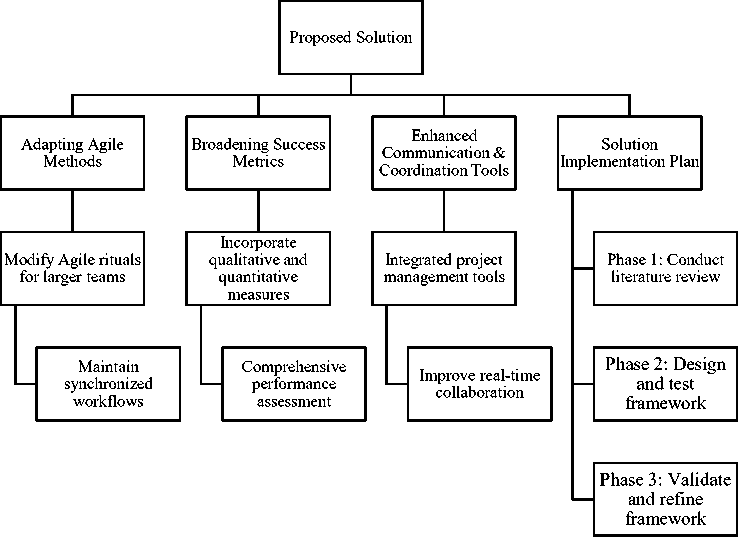
Fig. 1. The Proposed Framework
To facilitate continuous improvement, it is crucial to incorporate iterative learning processes within the broader success metrics framework. This involves creating structured feedback loops at various levels—team, cross-team, and organizational—to ensure that lessons learned from each iteration are systematically captured and applied. For instance, regular retrospectives should not only focus on process improvements but also emphasize knowledge sharing and learning across geographically dispersed teams. Tools like shared knowledge repositories, collaborative platforms (e.g., Confluence, SharePoint), and AI-driven analytics can help capture insights and disseminate them effectively across teams. Furthermore, establishing a culture of continuous learning where team members are encouraged to experiment, reflect, and adapt can significantly enhance project outcomes.
To ensure effective stakeholder engagement throughout the project lifecycle, it is essential to embed their involvement into the iterative processes inherent in Agile methodologies. This can be achieved through:
-
• Regular Feedback Loops: Establishing structured mechanisms for stakeholders to provide input at key milestones, such as sprint reviews, backlog prioritization sessions, and retrospectives. These feedback loops should be designed to capture both quantitative metrics (e.g., satisfaction scores) and qualitative insights (e.g., specific concerns or suggestions).
-
• Stakeholder-Centric Ceremonies: Incorporating ceremonies specifically tailored for stakeholder participation, such as product demonstrations, user acceptance testing, and co-design workshops. These activities ensure that stakeholders remain actively involved and their needs are continuously addressed.
-
• Transparent Communication Channels: Utilizing tools like collaborative platforms (e.g., Jira, Trello, or Confluence) to maintain transparency and enable stakeholders to track progress, review deliverables, and provide timely feedback.
-
4.3 Enhanced Communication and Coordination Tools
-
4.3.1 Facilitating Iterative Learning through Communication Tools
-
4.3.2 Managing Conflicts in Distributed Teams
By integrating stakeholders into these iterative processes, their feedback can be systematically incorporated into backlog refinement, prioritization decisions, and adaptation strategies, ensuring that the project remains aligned with evolving requirements and expectations.
The framework will first and foremost improve cooperation and communication in cases when the flow involves extensive and geographically spread-out teams. It will offer techniques and tools such as a single integrated project management tool, real-time project tracking charts, and professional information-sharing and collaboration tools. The framework will also describe how synchronous and asynchronous communication approaches, which will be essential to solve cooperation issues between geographically distant teams, can be supported. Ultimately, this approach will improve project performance and team morale because the ground for transparency will remain, trust between the members will be strengthened, and new issues will be solved quickly.
Effective communication tools are pivotal not just for coordination but also for facilitating iterative learning and adaptation. Platforms such as Slack, Zoom, and Microsoft Teams can host regular virtual meetings, workshops, and training sessions that focus on knowledge sharing and skill development. Additionally, real-time collaboration tools like Jira and Trello can track not only tasks but also learning milestones and adaptation strategies. These tools should be configured to support asynchronous communication, allowing team members in different time zones to contribute to discussions and share insights at their convenience. By leveraging these technologies, organizations can create an environment where continuous learning and adaptation become integral parts of the Agile process, even in large-scale distributed settings.
In large-scale distributed projects, conflicts between teams are inevitable due to differences in time zones, cultural backgrounds, and communication styles. Effective conflict management is crucial to maintaining team cohesion and project momentum. To manage conflicts, organizations should implement structured conflict resolution protocols that are integrated into their communication and project management tools. For instance:
-
• Clear Roles and Responsibilities: Clearly defined roles and responsibilities can prevent many conflicts by reducing ambiguity about who is responsible for what tasks.
-
• Conflict Resolution Frameworks: Establish frameworks that outline steps for resolving disputes, such as mediation processes or designated conflict resolution officers.
-
• Regular Check-ins: Frequent virtual meetings and check-ins can help identify and address potential conflicts early before they escalate.
-
• Cultural Sensitivity Training: Providing training on cultural awareness and sensitivity can help team members understand and appreciate diverse perspectives, reducing misunderstandings.
-
• Use of Collaboration Tools: Platforms like Slack, Microsoft Teams, and Zoom can facilitate open communication channels where team members can voice concerns and resolve issues collaboratively.
-
4.3.3 Facilitating Stakeholder Engagement through Technology
By proactively addressing conflicts through these measures, distributed teams can maintain a harmonious working environment that supports Agile principles and enhances overall project success.
Effective stakeholder engagement in large-scale distributed projects requires leveraging technology to bridge geographical and organizational gaps. Tools such as video conferencing platforms (e.g., Zoom, Microsoft Teams), collaborative workspaces (e.g., Miro, Slack), and project management software (e.g., Asana, Monday.com) play a critical role in enabling real-time interaction and asynchronous feedback collection. For example:
-
• Real-Time Collaboration: Live demos and virtual meetings allow stakeholders to participate in discussions, ask questions, and provide immediate feedback during key project phases.
-
• Asynchronous Feedback Mechanisms: Surveys, shared documents, and feedback forms can be used to gather input from stakeholders who may be in different time zones or unable to attend synchronous meetings.
-
• Dashboards and Reporting Tools: Providing stakeholders with access to real-time dashboards that display project progress, risks, and outcomes fosters transparency and enables them to make informed decisions.
-
4.3.4 Strategies for Balancing Resource Allocation Across Teams
These tools ensure that stakeholder feedback is captured efficiently and integrated into the project lifecycle without disrupting the flow of Agile processes.
Managing resources in large-scale Agile projects involves addressing challenges such as balancing workloads across multiple teams, ensuring skill alignment, and maintaining team capacity. The following strategies can help mitigate these challenges:
-
• Centralized Resource Pooling: Establish a centralized resource pool where team members’ skills, availability, and capacity are documented. This allows project managers to allocate resources based on project needs while avoiding overburdening specific individuals or teams.
-
• Cross-Team Skill Development: Invest in cross-training initiatives to ensure that team members can take on diverse roles as needed. This reduces dependency on specific individuals and enhances team flexibility.
-
• Dynamic Workload Balancing: Use Agile ceremonies like sprint planning and daily stand-ups to assess workload distribution across teams. Adjust priorities and redistribute tasks as necessary to prevent burnout and maintain productivity.
-
• Capacity Planning: Conduct regular capacity planning sessions to evaluate whether teams have the bandwidth to take on additional tasks. Incorporate buffer time for unexpected challenges or changes in scope.
-
• Dependency Management. Identify inter-team dependencies early and allocate resources accordingly to minimize delays. Use dependency mapping tools to visualize and resolve potential bottlenecks.
-
4.4 Implementation Plan
These strategies ensure that resource management remains agile, transparent, and aligned with the dynamic nature of large-scale projects.
The development of the framework will follow a phased approach:
-
• The first stage will include a literature review in order to identify current processes, challenges and agile scaling best practices. Scaling examples and failures will also be integrated into the formation of the framework during this phase as well as case studies and analyses of all attempts at scaling, successful and unsuccessful.
-
• The second phase will be to propose and test the above framework with professional input from Agile coaches, project managers and any other person that has worked on large-scale projects. Application of the framework will be done through pilot projects with a view of determining the viability of the framework in real life scenarios.
-
• In the last phase, the framework will be to be used in a number of organizations that will be selected with feedback loops done to help in making adjustments if necessary. This continues until the framework is reviewed and accredited as relevant, versatile, and appropriate in various settings within organizations.
-
4.5 Expected Outcomes
The proposed framework is expected to achieve several outcomes:
Three phases are recommended to implement the proposed framework.
-
• Phase 1: Preparation and Planning
-
• Phase 2: Implementation and Execution
-
• Phase 3: Evaluation and Refinement
-
5.1 Phase 1: Preparation and Planning
-
5.2 Phase 2: Implementation and Execution
-
5.2.1 Structured Feedback Loops for Continuous Improvement
-
5.2.2 Systematic Incorporation of Stakeholder Feedback
This phase lays the foundation for successful distributed Agile implementation by establishing clear communication channels and understanding between team members across various locations. The first step involves setting up a detailed organizational structure that delineates roles and responsibilities, ensuring every team member knows their tasks and how they fit into the larger project goals. Special attention is given to selecting appropriate communication and project management tools that cater to the needs of a distributed workforce. Tools like Slack for instant messaging, Zoom for real-time meetings, and Jira for project tracking are integrated into the workflow. Crucially, this phase also includes comprehensive training sessions designed to familiarize all participants with these tools and the adapted Agile processes, with a focus on overcoming the challenges posed by different time zones and cultural barriers. A buddy system is introduced to pair team members from different regions, fostering mutual understanding and smoothing over potential cultural frictions.
During this phase, the emphasis shifts to the active execution of Agile methodologies within the established framework. To tackle the challenges of coordination across time zones, overlapping hours are identified where team members can work synchronously, complemented by a rotating meeting schedule to ensure fairness in meeting times across regions. This phase also implements rigorous performance monitoring using advanced analytics and real-time dashboards that provide insights into team velocity, task completion rates, and communication effectiveness. These tools help identify any misalignments or delays early, allowing for timely adjustments. Regular and structured feedback loops are established, enabling continuous improvement of processes and interventions based on direct insights from team members' experiences. This feedback is crucial for refining communication strategies and workflow adjustments tailored to the nuances of distributed team dynamics.
During the implementation phase, rigorous performance monitoring using advanced analytics and real-time dashboards plays a critical role. These tools should be designed to provide actionable insights into both performance metrics and learning opportunities. Structured feedback loops need to be established not only for immediate task adjustments but also for long-term learning and adaptation. Regular retrospectives and review meetings should focus on identifying what worked well, what didn’t, and how processes can be improved. Insights gained from these sessions should be documented and shared across all teams to ensure that learning is not siloed but rather becomes a collective effort. This approach helps in continuously refining workflows and enhancing team dynamics, which is especially crucial in geographically separated large-scale environments.
During the implementation phase, performance monitoring systems and feedback loops should explicitly include following mechanisms for capturing and acting on stakeholder input.
• Sprint Reviews with Stakeholders: At the end of each sprint, stakeholders should be invited to review completed work, provide feedback, and validate that deliverables meet their expectations. This ensures that the project remains aligned with stakeholder priorities.
• Adaptive Backlog Prioritization: Stakeholder feedback collected during reviews and other interactions should directly influence backlog prioritization, ensuring that the most valuable features are developed first.
• Change Management Protocols: Establish protocols for managing changes based on stakeholder input, including assessing the impact of proposed changes, obtaining approval, and updating project plans accordingly.
5.3 Phase 3: Evaluation and Refinement
6. Validation
By embedding stakeholder feedback into these iterative processes, the project can remain flexible, responsive, and focused on delivering value.
The final phase is critical for assessing the viability and effectiveness of the implemented Agile framework across different teams and projects. It starts with pilot testing involving a select few teams to fine-tune the integration of Agile practices in a controlled environment, focusing on identifying best practices and areas for improvement. Insights gained from these pilots are used to adjust and optimize the framework. Following successful pilot tests, scalability tests are conducted to ensure the framework can handle larger teams and more complex projects without compromising the Agile principles of flexibility and rapid response to change. The culmination of this phase is the standardization of the refined Agile practices across the organization, accompanied by a detailed implementation guide and training resources. These documents and training modules are based on accumulated experiences and lessons learned throughout the earlier phases, providing a robust roadmap for future projects and ensuring sustainable Agile practices across geographically dispersed teams.
The validation process is a crucial step to test the feasibility, applicability, and effectiveness of all aspects of the Boilerplate Framework for scaling Agile practices in extra-large distributed settings. A structured survey was designed and distributed among Agile practitioners to capture feedback on three main objectives.
-
• First Objective: Tailoring Agile Practices for Large-Scale Distributed Projects.
-
• Second Objective: Enhancing Communication and Expanding Success Metrics.
-
• Third Objective: Establishing a Framework for Continuous Improvement.
In order to evaluate the degree of support of the participants for the different aspects of the framework, a five-point Likert scale was used where 1 referred to very low and 5 to very high support.
Objective 1: Adapt Agile Methods
Adapt procedures to multi-team environments
Test modifications through pilot projects
Ensure consistency

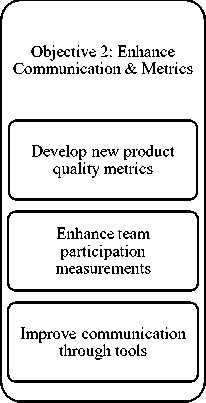
Objective 3: Sustain Continuous Improvement
Design feedback mechanisms
Implement review processes
Regular assessment of practices

-
Fig. 2. Streamlined Objectives for Scaling Agile in Distributed Projects.
-
6.1 Comprehensive Analysis of Questionnaire Responses for Goal 1
The collected survey data was represented with bar charts for better understanding the distribution of responses by the goals. These types of visualizations afford an understanding of characteristics of participant perception within multiple dimensions therefore facilitate the comprehension of leading patterns. The charts summarize the effectiveness and relevance of the proposed measures, highlighting the consensus levels (e.g., "Very High" and "High") and potential gaps indicated by lower ratings. These visualization aids help in making the right conclusion about the stability and future expansion of the framework.
The survey results highlight that the majority of respondents (41.39%) rated adjustments to Agile practices as "High," while 36.02% rated them as "Very High." All these together collectively imply that majority (77.41%) of participants supported the improvement of Agile methods for distributed environment. Only a small portion (6.44%) fell into the “Low" or "Very Low" categories, indicating minimal resistance to such modifications. The time synchronization and the pilot testing was also considered crucial, and the results provided here confirm that strategy. The data highlights the need to customize Agile as large-scale Global Agile projects pose scale and geographical distribution challenges.
Goal 1 Responses
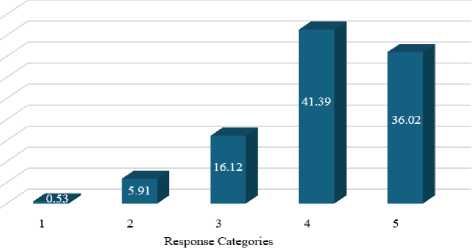
Table 2. Detailed Cumulative Outcomes for Goal 1.
|
Q. No |
Very Low |
Low |
Neutral |
High |
Very High |
|
1 |
0 |
3 |
1 |
7 |
20 |
|
2 |
0 |
0 |
2 |
14 |
15 |
|
3 |
0 |
1 |
7 |
19 |
4 |
|
4 |
0 |
2 |
8 |
13 |
8 |
|
5 |
0 |
4 |
4 |
11 |
12 |
|
6 |
1 |
1 |
8 |
13 |
8 |
|
Total |
1 |
11 |
30 |
77 |
67 |
|
Avg |
0.53% |
5.91% |
16.12% |
41.39% |
36.02% |
£ 20 pt
< 15
-
Fig. 3. Goal 1 Chart Summary Responses
-
6.2 Comprehensive Analysis of Questionnaire Responses for Goal 2
-
6.3 Comprehensive Analysis of Questionnaire Responses for Goal 3
The responses for Goal 2 reveal that 36.55% of participants rated broader metrics and integrated communication tools as "Very High," while another 36.55% rated them as "High." These ratings collectively present a near unanimous (73.10%) opinion on the need to Integrate team morale as well as product quality and incorporating better communication methodologies into Agility. Neutral ratings accounted for 15.59%, suggesting a modest level of uncertainty, while only 6.98% fell into the "Low" or "Very Low" categories. These findings confirm that improving communication instruments and extending conventional success factors are necessary to handle the nature of massive Agile projects.
Table 3. Detailed Cumulative Outcomes for Goal 2
|
Q. No |
Very Low |
Low |
Neutral |
High |
Very High |
|
1 |
0 |
0 |
3 |
13 |
14 |
|
2 |
0 |
3 |
6 |
13 |
8 |
|
3 |
1 |
0 |
9 |
6 |
12 |
|
4 |
0 |
6 |
5 |
11 |
8 |
|
5 |
0 |
2 |
1 |
15 |
12 |
|
6 |
1 |
0 |
5 |
10 |
14 |
|
Total |
2 |
11 |
29 |
68 |
68 |
|
Avg |
1.07% |
5.91% |
15.59% |
36.55% |
36.55% |
For Goal 3, a significant proportion of respondents (40.86%) rated the need for continuous improvement systems as "High," with 36.55% rating it as "Very High." Collectively, these (77.41%) suggest high support for such approaches as recurrent feedback and evaluation procedures to support the sustainability of the projects. A smaller percentage (14.51%) of neutral responses suggests some participants may view these as situationally dependent, while only 4.3% rated this goal as "Low," and none rated it as "Very Low." The results substantiate the use of frameworks that are both repetitive and sequential to enhance sustaining flexibility in Agile settings and to enhance the overall form of calls in the long run for coming projects.
Goal 2 Responses
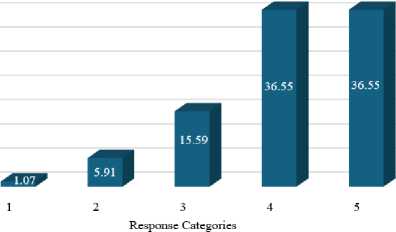
Fig. 4. Goal 2 Chart Summary Responses.
Table 4. Detailed Cumulative Outcomes for Goal 3
|
Q. No |
Very Low |
Low |
Neutral |
High |
Very High |
|
1 |
0 |
0 |
4 |
11 |
15 |
|
2 |
0 |
2 |
1 |
16 |
11 |
|
3 |
0 |
2 |
5 |
13 |
10 |
|
4 |
0 |
0 |
5 |
15 |
9 |
|
5 |
0 |
1 |
5 |
15 |
9 |
|
6 |
0 |
3 |
7 |
6 |
14 |
|
Total |
0 |
8 |
27 |
76 |
68 |
|
Avg |
0% |
4.30% |
14.51% |
40.86% |
36.55% |
-
6.3.1 Support for Iterative Learning Systems
-
6.4 Cumulative Evaluation of 3 Goals
The survey results indicate strong support (77.41%) for continuous improvement systems, underscoring the importance of recurrent feedback and evaluation procedures. Respondents emphasized the need for frameworks that are both repetitive and sequential, enabling sustained flexibility and long-term enhancements. This data suggests that implementing structured iterative learning processes—where teams regularly reflect, learn, and adapt—is not only feasible but highly valued in large-scale distributed projects. Ensuring that these systems are supported by robust communication and collaboration tools will further enhance their effectiveness, leading to better project outcomes and higher stakeholder satisfaction.
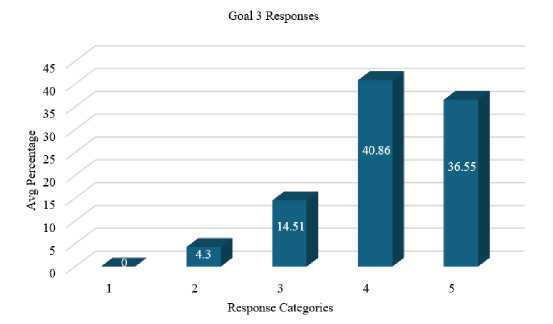
Fig. 5. Goal 3 Chart Summary Responses.
The combined result derived from the three goals presents a positive endorsement of the viability of scaling Agile solutions in distributed environments. "High" and "Very High" ratings dominate, with averages of 39.6% and 36.37%, respectively, while "Neutral" responses account for 15.41%, and "Low" and "Very Low" combined are only 5.9%. The total values, such as 118.8 for "High" and 109.12 for "Very High," highlight the framework's effectiveness in addressing large-scale Agile challenges and the importance of adapting practices, integrating advanced metrics, and fostering continuous improvement.
Table 5. Detailed Cumulative Evaluation of 3 Goals
|
Goal. No |
Very Low |
Low |
Neutral |
High |
Very High |
|
1 |
0.53 |
5.91 |
16.12 |
41.39 |
36.02 |
|
2 |
1.07 |
5.91 |
15.59 |
36.55 |
36.55 |
|
3 |
0 |
4.3 |
14.51 |
40.86 |
36.55 |
|
Total |
1.6 |
16.12 |
46.22 |
118.8 |
109.12 |
|
Avg |
0.53% |
5.37% |
15.41% |
39.6% |
36.37% |
Comulative Evaluation for 3 Goals
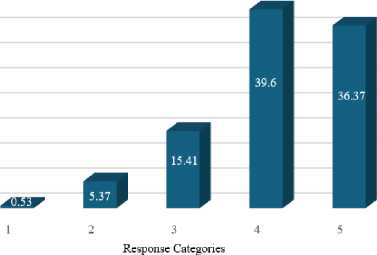
Fig. 6. Cumulative Evaluation for 3 Goals.
7. Conclusion and Future Work
Applying Agile at large scale and distributed software development projects present by challenges, especially in terms of coordination at multiple teams’ level, geographical dispersion, and changing stakeholder expectations. The recommendations herein propose the modification of Agile practices with better forms of communication, expansion of success indicators, and a phased manner of implementation in order to make the techniques uniformly effective. Consequently, the opportunity to have a fully developed proposed solution to such issues has shown how well it is possible to achieve synchronization in multiple workflows, foster better communication, as well as positively impact the overall project gains, as backed by empirical evidence together with pilot uses. Using the concepts of Agile and the understanding of the requirements of large-scale projects, this work offers practical recommendations for organizations that aim at reaching higher efficiency and satisfying the stakeholders in complex conditions.
To build on the findings presented in this study, future research should focus on several key areas. Firstly, exploring a broader array of success metrics would provide deeper insights into the comprehensive impact of Agile methodologies across diverse and geographically dispersed teams. Longitudinal studies are also essential to evaluate the long-term sustainability and effectiveness of the Agile framework implemented in various industries, enhancing our understanding of sector-specific adaptations. Moreover, integrating emerging technologies such as artificial intelligence and machine learning could significantly advance the analytical capabilities of Agile practices, offering new ways to enhance decision-making and risk management. While this study provides practical recommendations for adapting Agile practices to large-scale, distributed environments, further research is needed to develop and validate comprehensive risk management strategies tailored to these contexts. Future work could focus on creating detailed frameworks for identifying, assessing, and mitigating risks in multi-team settings, with an emphasis on addressing challenges such as cross-cultural communication, time zone differences, and inter-team dependencies. Additionally, empirical studies could explore the effectiveness of integrating risk management tools into existing Agile workflows, ensuring that risk-handling processes remain agile and scalable without compromising project flexibility or stakeholder satisfaction.

